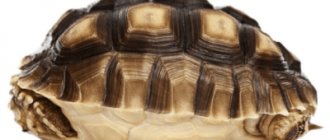The red-eared turtle is an amphibian animal that spends most of its time in the water, but from time to time crawls onto land to bask and sunbathe.
She needs them as much as water. Without sunbathing, which supports her vital functions, she simply will not be able to lead an active lifestyle. If the ambient temperature is too low, it may hibernate, thereby saving itself from the cold. Despite their unpretentiousness, to keep turtles at home, you need to know certain requirements for home care. First, you need to have a separate area that is spacious enough for the turtle to actively move around. Secondly, there should be enough water in this corner, but there should also be heated land. Heating is usually provided by an incandescent lamp. In addition, a quartz lamp is needed to irradiate the turtle with ultraviolet rays, which is very important, otherwise it may develop rickets. For normal development, your pet needs to be provided with a varied menu, which should include a variety of foods, both animal and plant origin.
At first glance, they are slow and are unlikely to be able to leave their corner in order to explore the surrounding territory, but this is far from the case. If the surface allows, for example, wood, then turtles can climb to any height and escape. But given the fact that aquariums are usually made of glass and at a certain height of the aquarium walls, it is unlikely that they will be able to do this. The only option left is children. They can take the turtles to play with them and just play enough and forget about them. In such cases, they may face several dangers: lack of water, long stay in uncomfortable conditions associated with lower temperatures, and receiving various injuries.
If a turtle climbs somewhere at floor level and the temperature is low enough, then after its body cools, it may fall into hibernation or simply lose its activity and be very difficult to find.
How long will the fugitives live?
Didn’t this experience force you to immediately carefully examine all the “toys” in the aquaterrarium? Along them, these tenacious and dexterous creatures, despite their apparent immobility, can climb to any height and fall to the floor, and then quickly scatter into dark corners?
Then we must add that it is very dangerous for the health of red-eared turtles to stay in the air without being able to plunge into water for more than 2-3 hours . Why?
This type of turtle is an amphibian, in nature they need fresh water, dense vegetation, a place where they can bask in the sun, and to build nests.
Charming reptile
In addition to water, the turtle needs land, where it can bask and receive ultraviolet baths. Therefore, when thinking about how to arrange a terrarium for a red-eared turtle, you need to select material for a floating island. It will need to be firmly attached to the base of the container.
It was already mentioned above how long a red-eared turtle can live without water. We will assume that no more than one day. It is this period that allows you to avoid health problems. It is also necessary to take into account that the turtle cannot live without daily walks on land. Therefore, observe the following rules:
- a floating island can occupy up to half of the aquarium;
- the exit to the shore should be inclined, smoothly rising from the bottom of the shore;
- the surface should be rough;
- the area should allow for quiet accommodation;
- it is very good if there are several islands.
What to do if the turtle managed to escape?
- First you need to put a bowl of water, and next to it a bowl of your favorite food. It is impossible that fresh and clean water could not interest this amphibian, and even more so, its favorite food. They have excellent eyesight and are able to spot treats from a great distance.
- If there is no reaction, and about 2 hours have passed since the escape, then you should fill several containers with water and place them in different places, such as dark corners, the space under the sofa, bed, under the table; this is necessary so that the turtle can find the nearest water and at least a little, but stay in it.
- Several hours without water can negatively affect its health: both its shell and skin can suffer. Under such conditions, the shell may begin to delaminate, and the delicate skin will begin to crack, as a result of which microcracks may appear on the skin, which will take a long time to heal.
- If time is running out and the turtle does not appear, then it is advisable to intensify the search, looking at all potentially dangerous places, since the pet could simply fall into a “trap”, despite the fact that they are able to actively move and overcome obstacles.
- The turtle can simply hide in a secluded place. As a result of active searches, contact with the turtle can be established. If she sees that someone is approaching her, she will certainly react to this by giving a kind of signal in the form of a whistle or clicks.
- If an adult turtle falls unsuccessfully onto its shell, it will be very difficult for it to get up, especially if there are some obstacles nearby.
In a different environment
This creature can spend quite a lot of time walking on land. But despite this, the natural environment is the underwater world. How long can red-eared turtles survive without water? It is quite difficult to answer this question. This depends on the age of the reptile, the pet’s well-being and general physiological condition.
What to do if your pet runs away? Should I worry that he will die? This is possible if the turtle was able to hide from you very well. No other reptile can survive as long as red-eared turtles can without water. She can walk for about a day without any harm to her health. 4-5 days are considered acceptable. There is evidence that escaped turtles lived in the air for up to a month. However, experimenting with your pet's health is not recommended; it may end badly.
Some tips
- You should not place the aquarium in direct sunlight, because overheating is possible, and this will also negatively affect its health. The aquarium should be divided into zones: a heating and eating zone and a swimming zone, while the temperature is maintained at an optimal level in one or another zone.
- It is not advisable to install the aquarium in drafts.
- There should be 2 thermometers in the aquarium: one thermometer controls the water temperature, the other controls the air temperature on the island.
- The diet may include food of plant and animal origin, and such food is given alternately.
- Feed is provided only for feeding times. After eating, the dishes are removed with any remaining food so that it does not get into the water.
- It is advisable that a powerful filter be installed in the aquarium to purify the water. If there is no filter, then it is advisable to change the water every 2-3 days. The fact is that turtles recover in water, and if you consider that the water temperature is around +25ºС, then the rapid development of microorganisms is possible.
- Turtles need to take baths followed by cleaning their shells of dirt and algae.
- In summer, when the temperature rises above +20ºС, turtles can be taken out into the fresh air for sunbathing. For these purposes, you can use an inflatable pool, installing it with a slope so that there is some dry land.
- If it is not possible to expose them to the sun, then the turtles can be irradiated with an ultraviolet lamp, and this procedure must be done regularly, otherwise rickets may develop.
- For the sake of the interior of the aquarium, you should not place all kinds of driftwood and sticks in the water. Due to the fact that the water is warm, the wood begins to quickly decompose and spoil the water.
- You should not add neighbors to turtles in the form of aquarium fish. Turtles love fish very much and will not mind eating it, so they will soon catch them and eat them.
In conclusion, I would like to say that no matter who they have at home, they need care, constant attention and constant costs. As a rule, children insist on such a choice, and parents cannot refuse them, and they do the right thing, since such a living corner of the house not only introduces children to the animal world, but also contributes to the formation of a certain worldview, the basis of which can be love for our smaller brothers . But this does not mean that, having satisfied the wishes of your child, the worldview will develop by itself. Unfortunately, it is not.
Choosing an aquarium
Before you bring your pet home, you need to prepare a house for it. A red-eared turtle at home will be very happy to walk on land, but it also really needs water. Ideally, this should be a terrarium. That is, a large cell in the middle of which there is a depression filled with water. But most often, an ordinary aquarium is taken, in which islands are set up.
A red-eared turtle at home can live long enough only if there are good conditions. And one of the most important factors is a large aquarium. For one individual 13 cm long, you will need a 100-liter bath. As it grows, you need to change it to a two-hundred-liter one.
Got sick after a walk
During its long walk, the turtle could get sick from a draft, get dehydrated, get hurt when falling, and other pets could injure it. Observe the animal after it has been found. Let's look at the most common diseases and their symptoms.
- Pneumonia. Your pet was walking in a draft and got cold. Hoarse breathing, thick liquid appears in the mouth, runny nose, and later you can hear squelching breathing. Treatment and dosage are prescribed by the doctor, mainly intramuscular antibiotics.
- Runny nose. Possibly from dust or hypothermia. The treatment is simple, you need to rinse your nose, each nostril in turn. When rinsing properly, the liquid should come out through the mouth. When a turtle has a runny nose, it needs to be warmed up well.
- Fractures. When falling from an aquarium. If the fracture is closed, then in principle it will heal on its own; if the fracture is open, then surgical intervention is necessary. In any case, consultation with a doctor is necessary.
- Dehydration.
At the beginning of our conversation, we found out how long a red-eared turtle can go without water. But, if you find it more than 5 days later. By signs you can determine the condition of your pet
Sunken eyes, lethargy, in some cases muscle twitching, also pay attention to the skin. When squeezed with two fingers, the skin should straighten; if this does not happen, it means your pet is suffering from dehydration.
The doctor must prescribe treatment, but usually this is water and a special solution.
- Worms. If worms are detected, the help of a doctor is necessary, because you cannot get rid of some types on your own. Some experts advise feeding your turtle raw, grated carrots as a treatment for them.
- Lacerations. The wounds may come from other pets. A dog or cat may have injured the turtle. If such a situation arises, then it is necessary to remove the turtle from the water to avoid infection and to stop the bleeding. Treat wounds with an alcohol-free antiseptic. If the wounds are serious, then you need to see a doctor to get stitches. Do not put it in water for 2-3 days until the wounds begin to heal.
- Conjunctivitis. This is a highly contagious disease. If you have several turtles, then the sick one needs to be removed, and the common aquarium needs to be cleaned and the water changed. With this disease, the turtle's eyes become very swollen. It is necessary to wash the eyes with chamomile decoction and drip antibacterial drops 2 times a day. If the disease is severe, you can use tetracycline eye ointment. The illness should go away within a week.
- Stomatitis. Bad odor from the mouth, swelling of the mucous membrane and purulent formations in the mouth are the very first symptoms of stomatitis. With this disease, the turtle must be placed in a separate container to exclude the possibility of infection of other animals. This is a serious disease that we strongly do not recommend treating on your own.
- Dermatitis. The main symptoms: peeling of the skin, the appearance of acne, ulcers on the shell and paws. All this is caused by improper care of the turtle. Change the water more often, check the temperature of the water and on the island, balance the diet. Treatment is prescribed only by a doctor.
- .Constipation and diarrhea. The causes of these diseases always turn out to be poor nutrition. Review the feeding process itself. After feeding, turn off the light above the aquarium only after the turtle has gone to the toilet, otherwise constipation may occur. Also check that there are no small stones or sharp shells at the bottom that it can swallow. If she has diarrhea, it means you are overfeeding her or giving her fatty foods.
Watch your animals. Take time for this, because the better you know their habits, you will immediately understand if your pet is sick and will not waste precious time treating it. Do not self-medicate, but contact specialists. A competent diagnosis and timely treatment are the key to your pet’s longevity!
This is interesting! A special shelter for turtles has been opened in Switzerland. Adults who are no longer able to be kept at home end up there.
Content Features
It is possible to extend the life of a turtle with proper maintenance. The reptile needs both land and water. The pet must live in an aquaterrarium. It is strictly forbidden to keep turtles in:
- basins;
- buckets;
- boxes and other containers not intended for keeping animals.
The following recommendations should also be observed when maintaining:
It is extremely rare to pick up reptiles. This is allowed only when cleaning the place of residence; Turtles grow rapidly and need a lot of space. For small individuals, an aquarium with a volume of about 50 liters is enough. It is gradually increased to 150 liters; Do not place the container on the window. The turtle's place of residence should be in the back of the room; During the cold season, it is undesirable to open windows in the room in which the aquarium is located.
Otherwise, the risk of a particular disease in the turtle increases; It is important to monitor the temperature in the container in which the pet lives; Do not overuse the arrangement of various plants in the aquarium. Some species may be toxic to reptiles; The stones must be large so that the pet cannot swallow them; The aquarium must have a dry area
This is necessary so that the red-eared pet can warm up if necessary. The area should not occupy more than 25-30% of the total volume of the aquarium; The land should be dense and located at a slight angle; The aquarium should be well lit. There are two lamps. One of them is for heating, and the other is for lighting; The water in the container must be purified. We must not forget about replacing it. The temperature should range from 20 to 25 degrees Celsius.
By following all recommendations, the lifespan of a red-eared slider will increase to 30-40 years. The main thing is to provide your pets with all the necessary conditions and care, then they will feel completely safe. If everything is done correctly, the reptiles will grow quickly and will always be in a positive mood.
Nutrition
Like any living creature, a turtle needs a complete set of nutrients and minerals. In nature, it feeds on crustacean fry and fish, but does not refuse plant food. Therefore, at home it is very important to ensure that the diet is as varied as possible and suitable for reptiles. It is best to use ready-made species that are available in pet stores.
Here the turtle also surprises its owners. She can live for two to three weeks without food. But a complete lack of appetite can be a sign of some kind of disease. Therefore, the fact that a reptile does not eat should not always be regarded as positive. But how many times a day to feed a red-eared turtle - this issue is decided individually, depending on the age and weight of the turtle.
How long do red-eared turtles live? How to determine age
CONTENT
Red-eared turtles are one of the most common pets, perfectly adapted for living in apartment conditions. They can rightfully be called long-lived reptiles, which is quite rare among domestic animals. There are known cases of turtles being inherited.
When a red-eared turtle is purchased, how long the reptile lives is interesting for any owner to know. The number of years lived in captivity directly depends on the conditions created by man.
Keeping red-eared turtles
Keeping red-eared turtles often turns out to be more difficult than expected at first glance.
Turtles spend most of their time in the water, although they definitely need land. An adult turtle needs an aquaterrarium with a volume of 100-150 liters, preferably that land occupies about 25% of its area. If possible, soil or crushed stone is poured on the shore. A gentle ascent with a rough but non-scratching surface is arranged to land. The water level must be greater than the width of the shell, so that if the turtle finds itself on its back, for any reason, it can turn over and not drown.
The water temperature in the aquarium should not be lowered below 20°C, the normal temperature is 24-30°C (it is advisable to install a heater to maintain the temperature). The water in the aquarium is replaced as needed, 1 - 2 times a week. A water filter allows you to do this much less often. However, a complete water change should be done at least once a month. It is advisable to install an incandescent lamp above the island in the aquarium. Turtles love to bask on dry land. Also, for the normal maintenance of a red-eared turtle, a source of dosed ultraviolet radiation is necessary.
In captivity, the diet of red-eared turtles includes small crustaceans such as gammarus or shrimp. Small aquarium or river snails, small or cut into pieces fish, meat cut into small strips, liver, small frogs, tadpoles, various insects and their larvae, earthworms, bloodworms, and tubifex are also suitable.
Do not forget that the diet of red-eared turtles should include foods rich in calcium: fish heads, bone meal, chalk, eggshells, etc. The diet of adult turtles also includes plant foods. Pets eat well dandelion leaves, cabbage, lettuce, spinach, and plantain. Among algae, duckweed, elodea, spirogyra, seaweed, anacharis, water beetle, edogonium, etc. are well eaten. Young red-eared turtles are fed 2 times a day. Later they are transferred to single meals. Turtles over 2 years old should be fed no more than 2-3 times a week.
You should not feed your turtle the same thing; the diet should be varied. The amount of food is selected so that the turtles eat everything without leaving anything in the water. Turtles should be fed at the same time every day. It’s good if the turtle has warmed up well before this. At a temperature of 28-30°, turtle digestion is much more intense. You can also feed turtles outside the aquarium, for example in a basin with water. This will help keep the aquarium clean. If the turtle's food is not particularly varied, it should be given vitamins or vitamin complexes. You can find them in pet stores; choose ones marked “for reptiles.” Vitamins are fed to hungry turtles in their food. The dosage must be looked at in the instructions for the drug.
Ultraviolet
Don't forget that it is vital for reptiles. The care and maintenance of red-eared turtles is not too complicated, but this nuance must be taken into account. Without ultraviolet radiation, a calcium deficiency occurs in the turtle's body. This is the path to rickets and the death of the animal. The ultraviolet lamp must shine 12 hours a day, since sunlight is not enough, because window glass does not transmit ultraviolet radiation. Therefore, consult a pet store in advance to buy exactly the lamp that your pet needs.
Features of appearance and life
The red-eared slider is easily recognized by its appearance. It differs significantly from other representatives.
So what features does it have:
- There is a stripe of red or orange color on the head;
- The surface of the armor covering is smooth and rounded;
- The color is olive green with characteristic black or yellow stripes;
- The species of red-eared turtles differ insignificantly. Young individuals have a richly colored shell. The coating darkens with age.
The size of an individual is determined by the length of the shell. Coverage is measured from edge to edge
In this case, you should not pay attention to the bending of the surface. Measurements are taken using a ruler
By about a year, the size of the reptile is 6-8 centimeters.
The size of the turtle is directly related to the conditions of detention and the subspecies of the pet. The aquatic reptile usually reaches a length of 20 to 30 cm. Males are smaller in size than females.
The age of a turtle is not precisely determined by its size. When well maintained, individuals are large. Only a specialist can tell the exact age of the turtle. Approximate data can be obtained based on the size of the shell. Approximate data is given in the table.
| Approximate age | Shell size |
| 11-12 months | 5-7 cm |
| 2 years | 7-9 cm |
| 3-4 years | 10-16 cm |
| 5-6 years | 14-20 cm |
The world's largest red-eared turtle has a shell length of 40 cm. Males are usually 5-6 cm smaller than females.
Main characteristics of the species
These are medium sized turtles. In the shell, their length varies from 18 to 30 cm. Sexual dimorphism is manifested mainly in size - males are much smaller than females.
Juveniles are bright green, allowing them to hide among plants. As turtles mature, they acquire olive or yellow-brown hues with characteristic patterns of yellow stripes. These stripes give the reptile an elegant look, which attracts many who like to fill their home with unusual animals.
On the head, neck and limbs the patterns are especially pronounced. In an adult turtle, they are a combination of white and green wavy stripes and spots.
Turtles do not have ears.
Why then did this turtle get the name red-eared? Those who name species have their own logic and flight of fancy
Apparently, the zoologist who named this species noticed the elongated bright red spots on both sides of the head
They extend along the head from the outer edge of each eye. These red (or maybe orange or even yellow) spots are located where ears would be if they had ears. So we got a bright name for an unusual turtle.
This species has a wide range. Initially, its representatives lived only in Central America and northwestern South America.
However, humans contributed to its spread to other regions. Now these turtles live in southern Florida, Arizona, Guadeloupe, Israel, South Africa, Spain, Great Britain and even Australia.
This turtle is considered aquatic, but it is able to go onto land, bask in the sun and move from body of water to body of water. She prefers to live in small fresh lakes, ponds and other bodies of water with low, swampy shores. It feeds equally on animal and plant foods. However, she has not been shown to have a predilection for carrion. She needs fresh game (crustaceans, fry, tadpoles, etc.) or fresh grass, including coastal grass.
Under favorable conditions, these turtles lead an active lifestyle.
They swim well and are quite capable of catching up with a small fish at a short distance.











